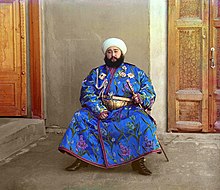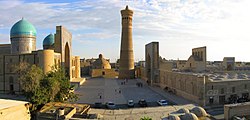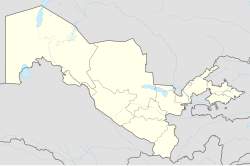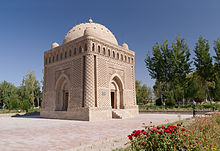Buxoro
|
Buxoro Бухоро |
||
| Russian : Бухара (Bukhara) | ||
|
Panorama over Bukhara |
||
| Basic data | ||
|---|---|---|
| State : |
|
|
| Province: | Buxoro | |
| Coordinates : | 39 ° 46 ' N , 64 ° 26' E | |
|
|
||
| Height : | 225 m | |
| Residents : | 235,517 (2008) | |
| Telephone code : | (+998) 65 | |
| Postal code : | 2001xx | |
| License plate : | 80-84 | |
| Structure and administration | ||
| Mayor : | Qiyomiddin Rustamov | |
| Website : | ||
Buxoro , German Bukhara ( pronunciation : [ ˌbuxɒˈrɒ ]; Tajik Бухоро Buchoro ; Persian بُخارا Buchārā , DMG Boḫārā , neo-Persian pronunciation : [ ˌboxɒ: rɒ: ], next to Bochoro ; Russian Бухара ), is one of the most important cities of Uzbekistan and the capital of the province of the same name .
The historic center of Bukhara with its architectural works of art, including numerous mosques and madrasas , has been a UNESCO World Heritage Site since 1993 .
The city is located on one of the old Silk Roads , had around 235,500 inhabitants in 2008 and is now one of the most important trade and industrial centers in Central Asia . Most of the city's residents are Tajiks and speak Tajik , the Central Asian form of Persian , as their mother tongue .
history
Early time
The oasis in which Bukhara is located lies in the historical landscape of Sogdia , which was initially part of the Persian Achaemenid Empire . From when the Bukhara settlement developed and when the city was founded is unknown. The oldest pottery found in the city dates from the Hellenistic period , when the region was part of the Greco-Bactrian kingdom that arose after the campaigns of Alexander the Great . Since some older settlements in the oasis have been archaeologically proven, earlier settlement activity in today's urban area cannot be ruled out. It is estimated that it was founded in the 6th century BC. Chr. The importance of the city in pre-Islamic times is reflected in the coins, which could shape the ruler of the city. In late antiquity , when the region bordered the New Persian Sassanid Empire , Bukhara was one of the prosperous Sogdian city-states that were primarily interested in long-distance trade. In the two or more centuries before the establishment of Islamic rule over the region, Sogdia - and with it Bukhara - was at the height of economic and cultural wealth.
From the arrival of the Arabs
673/674 began with the attack of Ubaidallah ibn Ziyad as part of the Arab campaigns of conquest, a series of raids by the Muslim Arabs against Bukhara, supported by troops of Turkish peoples. Although victorious in each case, the Arabs were initially unable to secure permanent rule over Transoxania. This only changed under Qutaiba ibn Muslim , who between 706 and 709 tried with difficulty to Islamize the inhabitants of Bukhara and was installed as ruler of Bukhara in 710. In early Islamic times, the rulers of Bukhara were known as Buchār Chudāt (or Buchār Chudāh ).
The Umayyads , however, had difficulty asserting themselves in Central Asia. Abu Muslim was partly responsible for the Abbasid victory , but his rule was not accepted in Bukhara, where the first revolt broke out in 750 and was bloodily suppressed. Further uprisings with various alliances and goals followed, for example between 776 and 779 under Al-Mukanna . This phase of unrest only came to an end when the Persian Samanids came to power in 865 and Bukhara became the capital of a powerful empire, a flourishing center of trade and handicrafts and a spiritual pole of Islam in the east.

After the end of the Samanid rule due to the invasion of the Turkish peoples, the place lost its political importance under the sovereignty of the Turkish Karakhanids from 999, but two important architectural monuments testify to the cultural prosperity of the city under the western Karakhanids: the Kalon Minaret ( Minār-i Qalyān , dated 1127 by an inscription) and the south facade of the Mag'oki Attori Mosque ( Masǧid-i maġāk-i ʿaʿārī ), which was renovated at that time . Above all, the long rule of Arslan Khan (1102–1130) was characterized by relative prosperity and stability. However, the western Qarakhanids had to recognize the supremacy of the Great Seljuks from the late 11th century , which was followed in 1141 by the non-Muslim Kara-Chitai . During this period of changing overlords (12th to early 13th centuries), Bukhara was ruled mostly by the local Burhanid dynasty, which consisted of a number of spiritual leaders ( Hanafites ) with the title Sadr . After the Khorezm Shah Atsiz had attacked the city in 1139/40, it was conquered in 1182 (and perhaps again in 1198) by his grandson Ala ad-Din Tekisch and finally came under the rule of Tekisch's son Muhammad II in 1207 .
From the Mongol rule
In 1220, Bukhara was captured by Genghis Khan's troops and largely destroyed. Under his successor Ögedei Khan , the rebuilt city, which had been repopulated by the refugees, was able to recover economically, even if there is little evidence of Mongolian building activity. Sustainable development was hindered, among other things, by conflicts within Mongolia and those between factions of the population, in 1238 the Tarabi uprising of the poor urban population took place. In 1263 the Mongolian Khan Hülegü conquered the city and killed several thousand people. Mongolian troops from Iran under Abaqa Khan followed in 1273 - again, many residents were killed and enslaved. In 1276 troops of the Ilkhan and the Chagatai Khan raided the rural areas of the Bukhara oasis. Overall, there was much severe destruction in the 1270s, allegedly with tens of thousands of deaths. Under Qaidu Khan and the administrator Masud Beg , the city was able to recover at the end of the 13th century.
During the Mongol period, Bukhara reached its lowest point and under the Timurids in the 14th century the city was just a provincial center in the shadow of Samarqand . In 1316 the city was completely devastated, in the 1330s Ibn Battuta described the city as "... sparsely populated and ruinous". By the end of the 15th century, Bukhara had lost its leading role in politics, the military, and trade, but retained it in science and mysticism.
From the succession struggles at the end of the Timurid period, a new power arose in Central Asia with the Uzbek khanate , under which Bukhara flourished again in the 16th and 17th centuries. The first Uzbek dynasty were the Scheibanids (1500–1599), whose capital became Bukhara in 1533 under Ubaidullah . In 1540 the Miri Arab Madrasa was opened. The city grew, became the most important in the whole of Central Asia and received numerous architectural monuments under Abdullah II. (Abdullah Khan), which determine the cityscape to this day. The subsequent Janids also left their mark on the city with brisk construction activity. In 1598 the Kazakh Khan Tawakkul advanced as far as Bukhara. When the Orthodox clergy pushed for the overthrow of the secular khan Nadir Mohammed in 1647 , the Indian Mughals hoped to use this dispute for the throne to recapture their old ancestral seats. An army of Shah Jahan conquered Bukhara in 1647 without encountering major resistance. The reluctant resistance of the Uzbeks weakened the army so much that the later Shah Aurangzeb ordered the withdrawal of his troops from Bukhara to India.
The political and military strength of the rulers of Bukhara declined after the heyday from the middle of the 17th century and the population declined. From 1710 the Keneges and Kitai Kipchaks allied and proclaimed an opposing Khan in Samarkand. In the following years, and especially around 1723, large groups of Kazakhs fled from the jungle to Bukhara and Samarkand. They allied themselves with various Uzbek groups and besieged Bukhara several times until 1729. Bukhara was badly devastated in 1730.
In 1740 the Persians under Nader Shah turned against Bukhara after the raid against Delhi . The Janids surrendered after the Bucharian army had been defeated due to the superior Persian artillery. The Shah entered Bukhara, which he regarded as an insignificant provincial city, and therefore refrained from looting and destroying it. The ruler Abu'l Faiz became a vassal of Persia. The decline of Bukhara ended under the Manghite dynasty from 1747.
From the rule of the Russians
The Emirate of Bukhara lost its independence after the Russian conquest of large parts of Central Asia. In contrast to the eastern parts of the emirate (including Samarqand), Bukhara and the surrounding area were not annexed by Russia and incorporated into the new General Government of Turkestan , but the Russian-Bucharian trade treaty of 1868 sealed Russia's de facto control of Bukhara, especially over its external relations and economy. The emirate continued to exist within the Russian Empire until 1920.
On September 2, 1920, the Red Army occupied Bukhara during the Russian Civil War . Seventy-five percent of the city is said to have been destroyed in heavy fighting. On September 14, 1920, the Soviet People's Republic of Bukhara (BNSR, from September 19, 1924 Soviet Socialist Republic of Bukhara , BSSR) was proclaimed, which was closely linked to the Soviet Union through a series of treaties with the Russian SFSR . In November 1924, Bukhara was incorporated into the newly established Uzbek Soviet Socialist Republic and thus into the Soviet Union. With the exception of the short-lived Baraq Khan Madrasa in Tashkent, which existed from 1956 to 1961, the Miri-Arab Madrasa with 60 university places, reopened in 1945, was the only Islamic educational institution in the Soviet Union. It was therefore also visited by Muslims from the Volga region who wanted to complete an Islamic-religious education. On September 1, 1991, Uzbekistan became an independent state.
population
- 1911: 70,000
- 1920: 50,000
- 2008: 235.517
People of the Jewish faith had settled here since Roman times. Since the 16th century these were known as Bukharan Jews . The Jewish cemetery in Bukhara has 10,000 graves, but in 2018 only 150 members of the community lived in the city, few of whom adhered to the rites.
Politics and administration
Buxoro is a district-free city in the province of Buxoro and at the same time its capital.
Twin cities
|
Cityscape and architecture
The historical center of Bukhara was added to the UNESCO World Heritage List in 1993 because it represents the most complete and unspoilt example of a medieval Central Asian city that has preserved its urban fabric to this day. In terms of urban structure and buildings, Bukhara had a profound influence on the development and planning of cities in a large area of Central Asia. In the Soviet era, generous streets and squares as well as numerous administrative buildings, hotels and buildings for educational institutions were built southeast of the old town.
Attractions
West of the old town is the Samanid mausoleum ( Ismoyil Somoniy maqbarasi ), the oldest preserved building in Central Asia, which was built in the years before Ismoyil Somoniy's death in 907 and had a strong influence on subsequent Islamic architecture. In its vicinity is the Chashmai Ayyub mausoleum (Hiobsbrunnenmusoleum) , which in its core probably dates back to the Timurid period, with a spring well that is said to go back to Job .
The citadel Ark , built in the 18th century on an artificial hill - on the site of the medieval predecessor building - houses the former palace of the Emir and a mosque from 1712. West of the citadel is the Registan and on its west side the Bolo-Hovuz Mosque . To the southeast of the citadel is the ensemble Poi Kalon with the Kalon minaret from 1127, which is a landmark of Bukhara, the Kalon mosque (15th century) and the Mir-Arab-Madrasa (1536) opposite it . In the Labi Hovuz ensemble in the center of the old town, the Koʻkaldosh Madrasa (1568), the Nodir Devonbegi Chanaqa and the Nodir Devonbegi Madrasa (1622), originally planned as a caravanserai, are grouped around a water basin.
The oldest surviving mosque in Central Asia from the 9th to 10th centuries, the Mag'oki Attori mosque , stands on the site of a former Sogdian temple. The oldest preserved madrasa in Central Asia is the Ulug'bek Madrasa , built in 1417 , which was juxtaposed with the Abdulaziz Khan Madrasa in 1652 according to the Kosch principle . In the vicinity of this ensemble stands the richly furnished Baland Mosque, which dates back to the Timurid period . The building complexes in which several different structures, e.g. B. Madrasa, mosque, and minaret, built together on one plot, include the Hodscha-Zaynuddin complex , the Hodscha-Gaukuschan complex and the Xalfa-Xudoydod complex .
Several of the sixteenth-century domed bazaars, mostly built over crossroads, still exist today, including the Toqi Sarrofon , Toqi Telpak Furushon , Toqi Zargaron and Tim Abdullah Khan . The four-tower building of Chor Minor , actually the gate or porter's house of a madrasa that has now disappeared, was built in 1807 by a wealthy merchant. The Xoʻjayev house , also built by a wealthy merchant in 1891, is a museum showing the home decor of the late 19th century as well as souvenirs of its last inhabitant, the communist politician Fayzulla Xoʻjayev .
Outside the historical center, the open Namozgoh Mosque is located in the south , the Sayfiddin Boharziy Mausoleum and the Bayan Kuli Khan Mausoleum in the east, the Fayzobod Chanaqa in the northeast and Sitorai Mohi Xosa , the about 4 kilometers to the north Summer palace of the last emir of Bukhara. To the west of the city is the Chor Bakr necropolis .
Impressions
Knife and scissors grinder (1981)
Economy and Infrastructure
traffic
Buxoro International Airport is to the east of the city.
The station Bukhara 1 is the train station of the city and is located on the Trans Caspian railway .
The M37 trunk road , which is a section of the European route 60 from the Turkmen border to Samarqand , and the A380 from Nukus to Gʻuzor cross in Buxoro .
education
- State University of Buxoro
- Buxoro Technological Institute for Food and Light Industry
- Buuxoro State Medical Institute Abu Ali Ibn Sina
- Branch of the Tashkent Institute for Irrigation and Land Reclamation
Culture
theatre
The Bukhara Music and Drama Theater Sadriddin Ayni and the Bukhara Puppet Theater are located in Buxoro .
Museums
The Buxoro State Architecture and Art Museum with its departments for history, numismatics and epigraphy, contemporary history and ethnography as well as nature is well worth a visit . It also includes collections of decorative and applied arts, books and documents, and the Kamoliddin Behzod Art Museum .
Sports
The football club FK Buxoro is playing in the top Uzbek division for the 2011 season. The home ground is the city's 22,700-seat stadium, which was opened in 2002. The Bukhara Challenger tennis tournament was held in Bukhara from 2000 to 2008 .
sons and daughters of the town
- al-Buchari (810–870), important Islamic scholar and hadith collector
- al-Kalābādhī († 10th century), Persian Sufi , author of the Kitab at-ta'arruf
- Narschakhi (around 950), full name: Abu Bakr Muhammad ibn Jafar Narschakhi (or Narschachi), Persian historian ( Tārich-e Bochārā ) from Narschak.
- Avicenna , Latinized from Ibn Sīnā (980-1037), born in Afshāna, famous Persian doctor and philosopher - one of the most important scholars of the Middle Ages
- Sayyid Ajall Shams ad-Din Umar (around 1210–1279), official of the Yuan dynasty and the first governor of China in the Yunnan Province
- Abdurauf Fitrat (1886–1938), Jadidist politician, writer and agitator
- Fajsulla Chodschajew (1896–1938), Soviet-Uzbek politician
- Sorodschon Yusufova (1910–1966), Soviet-Tajik geochemist and university professor
- Muchtar Aschrafi (1912–1975), Uzbek-Soviet composer
- Muhammadschon Shakuri (1925–2012), Tajik writer and literary scholar
- Bakhtiyor Ichtiyarov (* 1940), Soviet-Uzbek actor
- Iskander Machmudow (* 1963), Russian entrepreneur of Uzbek origin
- Oksana Chusovitina (* 1975), German-Uzbek gymnast
- Ulugʻbek Baqoyev (* 1978), Uzbek football player
- Sitora Farmonova (* 1984), Uzbek actress
- Shavkat Salomov (* 1985), Uzbek football player
- Ixtiyor Navroʻzov (* 1989), Uzbek wrestler
- Nigina Sharipova (* 1995), Uzbek sprinter
In the picaresque novel Chodscha Nasreddin by Leonid Wassiljewitsch Solowjow , Bukhara is the hometown of the hero.
literature
- Anette Gangler, Heinz Gaube , Attilio Petruccioli : Bukhara - The Eastern Dome of Islam . Axel Menges, Stuttgart 2004, ISBN 3-932565-27-4 .
- Ashirbek Muminov et alii .: Islamic education in Soviet and post-Soviet Uzbekistan. In: Michael Kemper, Raoul Motika and Stefan Reichmuth (eds.): Islamic Education in the Soviet Union and Its Successor States . Routledge, London, 2010. pp. 223-279.
- Attilio Petruccioli (ed.): Bukhara. The Myth and the Architecture . Aga Khan Program for Islamic Architecture, Cambridge 1999, ISBN 88-86805-00-7 .
- Yuri Bregel : An Historical Atlas of Central Asia . Brill, Leiden 2003, ISBN 90-04-12321-0 , p. 80f with plate 40 City map of Bukhara in the 19th century .
- Jalol Ikromij : The Twelve Gates of Bukhara ( Tajik Дувоздаҳ дарвозаи Бухоро , Russian Двенадцать ворот Бухары ), 1961–1974 (a historical trilogy)
- Jürgen Paul : Central Asia. S. Fischer, Frankfurt am Main 2012 ( New Fischer World History , Volume 10).
Web links
- Old town of Buxoro on the UNESCO World Heritage Center website ( English and French ).
- Bernhard Peter: Bukhara - essays and photo galleries . Architecture and architectural history, many floor plans of historic buildings
- Bukhara Museum website
Remarks
- ↑ From Arabic مدرسة, DMG madrasa 'place of teaching', pluralمدارس, DMG madāris .
- ↑ Gangler, Gaube, Petruccioli, pp. 18f
- ↑ Gangler, Gaube, Petruccioli, p. 19 ff
- ^ Jürgen Paul: Central Asia. 2012, p. 290
- ↑ Gangler, Gaube, Petruccioli, pp. 23f
- ^ Jürgen Paul: Central Asia. 2012, p. 290
- ↑ See Muminov et alii: Islamic education in Uzbekistan . 2010, p. 251.
- ↑ Lazar Israelowitsch Albaum, Burchard Brentjes: Lords of the Steppe. On the history and culture of Central Asian peoples in Islamic times. VEB Deutscher Verlag der Wissenschaften, Berlin 1978, p. 115.
- ^ Jürgen Paul: Central Asia. 2012, p. 358
- ^ Jürgen Paul: Central Asia. 2012, p. 359
- ↑ Lazar Israelowitsch Albaum, Burchard Brentjes: Lords of the Steppe. On the history and culture of Central Asian peoples in Islamic times. VEB Deutscher Verlag der Wissenschaften, Berlin 1978, p. 116.
- ^ Jürgen Paul: Central Asia. 2012, p. 356
- ↑ Gangler, Gaube, Petruccioli, p. 28 f.
- ↑ Annette Gangler: Bukhara from the Russian Conquest to the Present . In: Petruccioli 1999, p. 150
- ↑ See Muminov et alii: Islamic education in Uzbekistan . 2010, p. 250f.
- ↑ . See Dilyara Usmanova et alii .: "Islamic Education in Soviet and Post-Soviet Tatarstan" in Michael Kemper, Raoul Motika and Stefan Reichmuth (ed.): Islamic Education in the Soviet Union and Its Successor States. Routledge, London 2010. pp. 21-66, here: pp. 48 f.
- ^ In Bukhara, 10,000 Jewish Graves but Just 150 Jews , New York Times, April 7, 2018
- ↑ lit. (Persian): "School of the four minarets".
- ↑ Rationale of UNESCO (PDF file; 1.8 MB), (accessed on May 8, 2011)
-
^ Edgar Knobloch: Turkestan . Prestel, Munich 1978
Klaus Pander: Central Asia . DuMont Reiseverlag, 2004 - ↑ Uzbek Ministry of Culture and Sports ( Memento from April 30, 2008 in the Internet Archive ) (accessed April 30, 2008)














